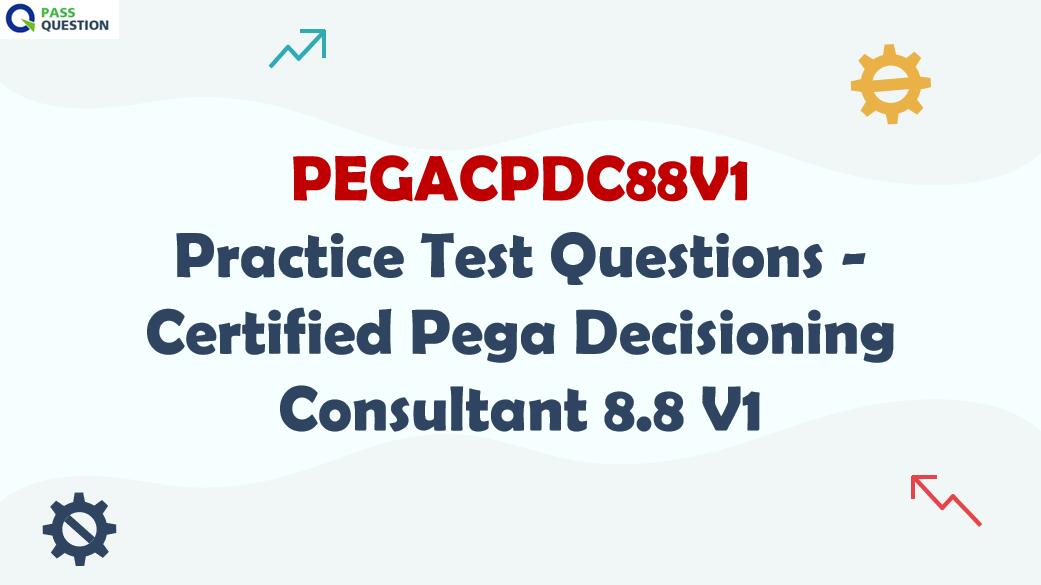PEGACPDC88V1 Practice Test Questions - Certified Pega Decisioning Consultant 8.8 V1
Preparing for the Certified Pega Decisioning Consultant 8.8 V1 exam can be challenging, as it requires a solid understanding of various concepts and principles related to Pega Decisioning. However, PassQuestion latest PEGACPDC88V1 Practice Test Questions can be an excellent resource to help you pass the exam easily. These PEGACPDC88V1 Practice Test Questions cover all the exam objectives and are designed to provide you with a comprehensive understanding of the various topics covered in the exam. They can help you identify your strengths and weaknesses and focus your preparation efforts accordingly. Furthermore, PassQuestion regularly updates its PEGACPDC88V1 Practice Test Questions to ensure that you have access to the most current and relevant content.

Certified Pega Decisioning Consultant Certification
The Certified Pega Decisioning Consultant certification is a highly sought-after certification that is designed for professionals who are actively participating in the design and development of a Pega Customer Decision Hub solution. This certification ensures that candidates possess the necessary skills to apply design principles of Next-Best-Action Designer, 1:1 Operations Manager, Decision Strategies, and Predictive Analytics in a real-world scenario. It is widely recognized as a benchmark for competence and proficiency in Pega Decisioning, and is a great way for professionals to enhance their career prospects in this field. The exam is rigorous and includes multiple choice, scenario-based, and drag-and-drop questions, designed to test the candidate's knowledge and understanding of the various concepts and principles that are essential for success in this role.
CPDC Version 8.8 Exam Information
Exam Code: PEGACPDC88V1
Type of Exam: 60 question exam
Length: 90 minutes
Passing Grade: 70%
Language: English
CPDC Version 8.8 Exam Objectives
Next-Best-Action concepts (10%)
One-to-one customer engagement
Optimize the customer value in the contact center
Essentials of always-on outbound
Define the starting population
Actions and treatments (12%)
Define and manage customer actions
Present a single offer on the web
Define an action for outbound
Engagement policies (12%)
Define customer engagement policies
Create an engagement strategy
Customer journeys
Contact policy and volume constraints (13%)
Avoid overexposure of actions
Avoid overexposure of actions on outbound
Limit action volume on outbound
AI and Arbitration (8%)
Action arbitration
Action prioritization with AI
Prioritize actions with business levers
Channels (10%)
Real-time containers
Create a real-time container
Send offer emails
Share action details with third-party distributors
Decision strategies (25%)
Create and understand decision strategies
Create engagement strategies using customer credit score
Create eligibility rules using customer risk segments
Business agility in 1:1 customer engagement (10%)
Agility in a customer engagement project
Change management process
Building your business operations team
Life cycle of a change request
Change request types
Launching a new offer on web
Updating existing actions
Implementing business changes using Revision Manager
View Online Certified Pega Decisioning Consultant 8.8 V1 PEGACPDC88V1 Free Questions
1. U+ Bank wants to use Pega Customer Decision Hub to display a credit card offer, the Standard Card, to every customer who logs in to the bank website. What three of the following artifacts are mandatory to implement this requirement? (Choose Three)
A.Customer engagement policies.
B.An action and the associated web treatment.
C.Real-time containers.
D.Customer contact policies.
E.A business structure.
Answer: B, C, E
2. What is the name of the property that the system computes automatically when you use an Adaptive Model decision component?
A.Order
B.Propensity
C.Rank
D.Priority
Answer: B
3. U+ Bank uses a scorecard rule in a decision strategy to compute the mortgage limit for a customer. U+ Bank updated their scorecard to include a new property in the calculation: customer income.
What changes do you need to make in the decision strategy for the updated scorecard to take effect?
A.Remap the scorecard property in the decision strategy for the change to take effect.
B.Add a new Group By component for the mortgage limit calculation.
C.The score calculation is independent of the strategy and no change is required.
D.A new proposition filter needs to be configured in the strategy to filter on customer income.
Answer: C
4. U+ Bank wants to send promotional emails related to credit card offers to their qualified customers. The business intends to use the same action flow template with the desired flow pattern for all the credit card actions.
What do you configure to implement this requirement?
A.File template
B.Dynamic template
C.Output template
D.Email treatment
Answer: B
5. U+ Bank implemented a customer journey for its customers. The journey consists of three stages. The first stage raises awareness about available products, the second stage presents available offers, and in the last stage, customers can talk to an advisor to get a personalized quote. The bank wants to actively increase offers promotion over time.
What action does the bank need to take to achieve this business requirement?
A.Enable increasing stage upweighting for the second stage of the journey.
B.Upweight the propensity by adding more predictors that fit the target customers and repeat this process over time.
C.Enable increasing stage upweighting for the first stage of the journey.
D.Enable constant stage upweighting for the second stage of the journey.
Answer: A
6. U+ Bank implemented a customer journey for its customers. The journey consists of five stages. The bank observes that as customers progress through the journey, one customer entered the third stage of the journey, and then received an offer that is not included in any journey.
Which statement explains the cause of this behavior?
A.The bank implemented upweighting for the third stage.
B.The customer was not eligible for the last stage of the journey and the system presented an offer outside the journey.
C.The customer can be involved in only one active journey at a given moment.
D.The customer always receives the most relevant action, even if an action is not a part of any journey.
Answer: D
- TOP 50 Exam Questions
-
Exam
All copyrights reserved 2025 PassQuestion NETWORK CO.,LIMITED. All Rights Reserved.

